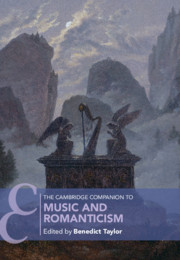Book contents
- The Cambridge Companion to Music and Romanticism
- Cambridge Companions to Music
- The Cambridge Companion to Music and Romanticism
- Copyright page
- Contents
- Figures
- Tables
- Musical Examples
- Contributors
- Preface
- Chronology
- Part I Horizons
- Part II Worlds
- 3 Music and Romantic Literature
- 4 Music, Romantic Landscape, and the Visual
- 5 Romanticism, the Folk, and Musical Nationalisms
- 6 Music, Romanticism, and Politics
- 7 Music and Technology
- 8 Music, Magic, and the Supernatural
- 9 A Kingdom Not of This World: Music, Religion, Art-Religion
- Part III Aesthetics
- Part IV Practices
- Part V Histories
- Select Bibliography
- Index
- References
7 - Music and Technology
from Part II - Worlds
Published online by Cambridge University Press: 06 August 2021
- The Cambridge Companion to Music and Romanticism
- Cambridge Companions to Music
- The Cambridge Companion to Music and Romanticism
- Copyright page
- Contents
- Figures
- Tables
- Musical Examples
- Contributors
- Preface
- Chronology
- Part I Horizons
- Part II Worlds
- 3 Music and Romantic Literature
- 4 Music, Romantic Landscape, and the Visual
- 5 Romanticism, the Folk, and Musical Nationalisms
- 6 Music, Romanticism, and Politics
- 7 Music and Technology
- 8 Music, Magic, and the Supernatural
- 9 A Kingdom Not of This World: Music, Religion, Art-Religion
- Part III Aesthetics
- Part IV Practices
- Part V Histories
- Select Bibliography
- Index
- References
Summary
Romantic music has often been seen as an exploration of ideal, disembodied realms of spirit and feeling. It has also been presented as a consolation against the violent changes, profound uncertainties, and fierce social tensions of industrial modernity. Yet technical inventions and adaptions, such as new and improved instruments and new lighting and staging techniques, were at the heart of many of the defining characteristics of Romantic music: these included the sense of wild, dangerous, creative energies in both nature and human arts, the exploration of the most exalted and sombre of human emotions and states, restless formal invention, and appeals to both the intimacy of the individual soul and to vast audiences. Romantic music was bound up with industrialisation, urbanisation, and imperial expansion. Through its dependence on technology, and its ability to reflect upon technology’s consequences, Romantic music was an exemplary manifestation of its age.
Keywords
- Type
- Chapter
- Information
- The Cambridge Companion to Music and Romanticism , pp. 110 - 126Publisher: Cambridge University PressPrint publication year: 2021



